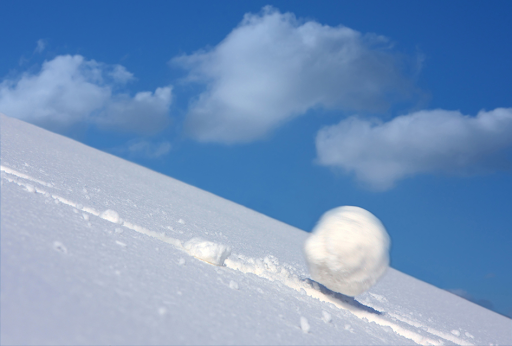📫 Join thousands readers. New videos & articles in your inbox
Decision Making and Problem-Solving
I just finished writing the introduction to one of the “ThinkGym Journaling Method Book” chapters called Decision Making and Problem-Solving Pillar. And I am sharing it here.
Unfortunately, these things are not taught in school (as far as I know).
And took me just half a day to write it and a few years to understand it deeply…
So here it goes:
_____

I want you to imagine that now it is winter and you are standing on the top of a big 10 km in height mountain covered with a lot of snow.
You make a small snowball the size of a football ball and push it from your place downhill.
It starts rolling and rolling, and in a few moments, this ball becomes bigger.
In just 30 seconds, it became as tall as a man, and in 1 minute, it became a house size huge snow roller that could demolish anyone standing in its way.
Luckily there are no people, no buildings on the bottom of the mountain, and you're small turned into a giant ball crashes facing the ground.
Now think about this small initial snowball you dropped as your first decision. With time, this decision will have consequences and will or will not create new problems.
- And more often than not, the other problems that occurred on the way of the ball are the results of that first initial decision.
- And the following decisions are the results of the previous decisions.
- In short, we often deal with the consequences of some big decision we are unaware of, suppressed, unconscious, or even forgotten about (our brains like to play this game).
Here are a few crucial points about consequences to hold in mind when working on this pillar:
- It is harder to stop a snowball (but possible) when it is already falling in the middle of a mountain.
- Trying to protect things at the bottom of the mountain is sometimes a bad idea; your mission should be to prevent throwing balls from the top.
Every day we make hundreds if not 1000ds of decisions.
And, of course, our life becomes what it is as a summary of daily decisions.
When you learn to make better decisions, your life becomes better.
The same goes about problem-solving: daily, we solve many small and big problems, and the results and quality of our lives depend on our ability to solve problems efficiently.
Decision-making and problem-solving are not the same, but they closely interconnect and influence each other. That's why I decided to put them under one pillar.
In this pillar, you will be able to practice a few good exercises in your journal to start training your abilities to make better decisions and solve life problems.
And a few more important points I want you to remember practicing this pillar (they can sound simple, but I learned them from a challenging experience):
- If you do not make a timely decision, then sooner or later, some external force (people, events, circumstances, etc.) will decide for you. This external force can even push or force you to make a decision where you likely will have fewer options or control if you do it yourself.
- If you do not try to solve the problem, then this problem can get bigger with time, or it can become more complicated to solve.
- Suppose you close your eyes to a problem or decision. In that case, it will not disappear in most cases. When you are aware of it and do nothing currently: you know you are doing nothing and not expecting change. You take responsibility for not solving the problem. This is important because it will help you remove false expectations and blame others or yourself.
Using journaling for decision-making and problem-solving has many benefits, and some of them are:
- You can articulate the decision/problem in a written form and understand it better.
- You can make better quality decisions and solve problems effectively by putting time and attention into the process.
- You have some tools that you can rely on that give you some starting structure and do not spin everything in your head.
- You can track your progress and spend the maximum necessary time on a problem or decision instead of procrastinating (spending too much time) or overreacting (spending too little time)
Next, go exercises…
You may like this posts as well
📫 New guides and articles in your inboxJoin thousands readers. You'll get new guides, videos and posts as soon as they're published.

Hive by Alex Zozovsky is a Journaling Academy and Community For Personal Growth, Elite Performance, Mental + Emotional Thriving.
Hive members learn the best thinking tools for top performance and life satisfaction.
To accomplish this, they go through interactive online transformational experiences: quests, adventures, challenges, and guides.
Unlike books or usual courses, these trainings use NarrateLearning™ method (step-by-step narrative learning approach) to learn decision-making,
problem-solving, working with intuition and subconscious,
raising self-esteem and confidence, managing emotional well-being, idea generation, creativity,
mental toughness, and working with beliefs to improve their mindset and performance.

Hive members learn the best thinking tools for top performance and life satisfaction.
To accomplish this, they go through interactive online transformational experiences: quests, adventures, challenges, and guides.
Unlike books or usual courses, these trainings use NarrateLearning™ method (step-by-step narrative learning approach) to learn decision-making,
problem-solving, working with intuition and subconscious,
raising self-esteem and confidence, managing emotional well-being, idea generation, creativity,
mental toughness, and working with beliefs to improve their mindset and performance.
📫 New guides and articles in your inboxJoin thousands readers. You'll get new guides, videos and posts as soon as they're published.
128 City Road, London, Unated KingdomContact us Privacy policy Terms of service Refund policy